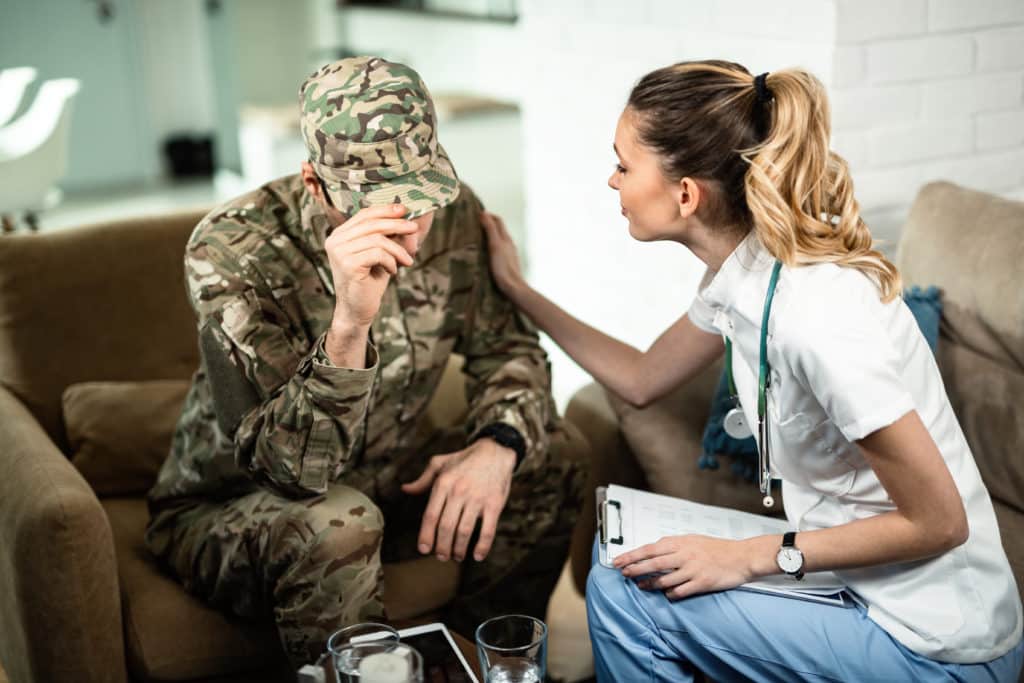Many people ask how many veterans suffer from PTSD and what is the percentage of veterans with PTSD getting help. If you have ever served or have family who has served, it is important to know the signs of PTSD and get treatment where needed.
Post-traumatic stress disorder, or PTSD, is a mental health problem. It develops after an individual experience or sees life-threatening events. It’s perfectly normal to have stressful reactions to disturbing or life-threatening events. Most people return to normal after a few weeks or a few months. For some, the feelings don’t go away, and that’s when it’s time to learn how many veterans suffer from PTSD and what treatment options are available.
Water Gap Wellness Center is a mental health retreat in Pennsylvania offering treatment to those in need. To learn more about our mental health programs, call today.
Why is PTSD Common For Veterans?
How many veterans have PTSD, and why is it so common? All military members deployed to war zones are likely to see combat. Their missions can expose them to disturbing and life-threatening experiences that lead to PTSD.
The high percentage of veterans with PTSD is related to many factors.
- War zone deployments
- Training accidents
- Military sexual trauma
- What one did in the war
- How often was one deployed
- The politics involved in the war
- Where one fought
- The type of enemy fought
How Many Veterans Have PTSD?
When military members return from a deployment to a war zone, they undergo a medical evaluation to determine their risk of PTSD. In most cases, mild signs of PTSD are considered normal given the circumstances, so the servicemember is left to return to their duties and personal lives. Individual branches may or may not provide follow-up assessments over the months and years that follow a deployment. If signs are still present months or years after an initial return from a warzone, then the government might offer help.
However, this varies from branch to branch and servicemember to servicemember.
- Some servicemembers lie about their signs in order to protect their jobs and security clearances.
- Others don’t recognize signs of PTSD in themselves.
- Still, some don’t get follow-up help when the signs get worse.
According to the U.S. Department of Veterans Affairs, up to 12% of veterans from Operation Iraqi Freedom and Enduring Freedom have PTSD, and 12% of veterans from the Gulf War have PTSD. During the 1980s, it was thought that only fifteen percent of Vietnam veterans had PTSD, but over time it became clear that thirty percent of veterans from the Vietnam War had PTSD at some point in their life.
What Are the Signs That a Veteran Suffers From PTSD?
After a traumatic event, it’s normal to have sleeping issues, feel on edge, or struggle with upsetting memories. At first, it can be difficult to return to daily activities like going to school, doing your duty, or spending time with your family. After a few weeks or months, most people return to normal.
But if it’s been more than a few months and those feelings of trauma are causing problems in daily life, it might be a sign that a veteran is struggling with PTSD. There are four main signs of PTSD:
Reliving the Event
Many people who ask how many veterans have PTSD are asking because they are a veteran or a family member close to them is a veteran. The first sign is called re-experiencing. This is when memories of the traumatic event come back. A veteran might experience:
- Nightmares
- Flashbacks
- Triggers like fireworks, news reports, seeing accidents
Avoiding Reminders
Sometimes veterans avoid situations or people that remind them of the causes of their PTSD. Some veterans might avoid thinking about the event or talking about it at all. A veteran might:
- Avoid crowds they perceive as dangerous
- Avoid driving, especially if military convoys were bombed
- Stay unnecessarily busy to try and avoid thinking about the event
Having Negative Thoughts
Veterans might have negative thoughts and feelings about themselves and the world, thinking that it’s dangerous and no one can be trusted. Some veterans experience a feeling of numbness with a complete loss of interest in things they once enjoyed or people they once loved.
Hyperarousal
Hyperarousal causes veterans to be jittery and regularly on the lookout for danger. A veteran might be startled by loud noises, and find it difficult to concentrate or sleep.
How to Find Veteran PTSD Treatment Programs Near New York
Learning how many veterans suffer from PTSD can be shocking for many people. Being able to find Tri-State area mental health treatment programs may be lifesaving for some, which is why Water Gap Wellness Center is here to help.
Water Gap Wellness Center offers veteran PTSD treatment programs near New York. Our PTSD program uses trauma-informed therapeutic approaches to help avoid retraumatization or triggers during your recovery process. Our facility is a private, secluded location with over 38 acres where you can get the mental health treatment you need in a natural, peaceful environment.
Let Water Gap Wellness Center help you find PTSD treatment today.




